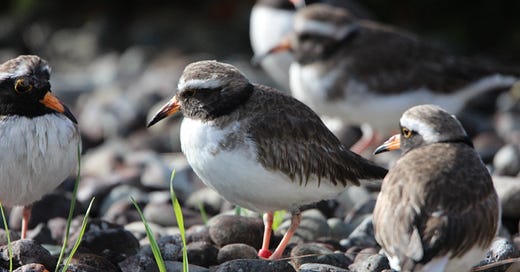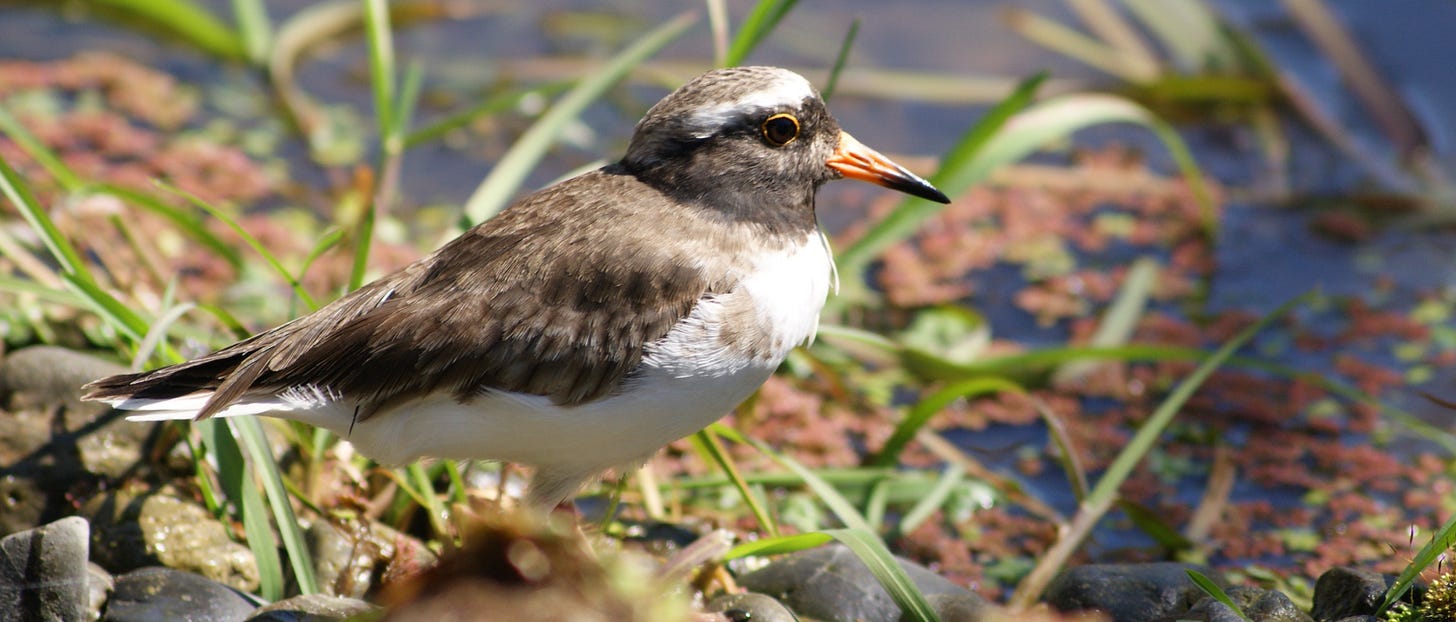Welcome to The Turnstone. Here, I help people understand important issues such as Covid-19, climate change and conservation. I send my articles out every Sunday - if you’d like them emailed to you directly, you can sign up to my mailing list.
I was nine years old when I first heard of the Chatham Islands black robin. Like many New Zealanders, I learned of these birds when the documentary “Seven Black Robins” screened in 1981, as part of the television series Wild South. I watched the story of their transfer from a fragment of dying forest on the clifftop of Little Mangere Island, one of the Chatham Islands, where only seven birds survived in all the world. Although the birds survived the transfer and were able to breed at their new home on nearby Mangere Island, there were simply too few of them. And so, in the next programme about them, I watched as their eggs were removed from their nests and placed in the nests of the Chatham island warbler, a relative of the mainland grey warbler or riroriro. The strategy allowed the black robins to produce a second clutch of eggs and, for the first time in years, they were able to raise three chicks to maturity in one season. Although the population was still tiny, there was cause for hope.
Over the following years, the strategy of removing eggs to be raised by another bird species continued. Tomtits, a close relative of the black robin, proved to be better foster parents. After a few years of intense management, and with the help of the tomtit, the black robin population increased to around 60 birds on two islands, Mangere Island and another of the Chatham Islands, Rangatira (South East Island). Every bird was the descendant of one female, Old Blue, so named because of the colour of her leg band.
The story of Old Blue and the black robins fascinated me, and I wasn’t alone. The whole of New Zealand followed the story of these critically endangered birds. When Old Blue died, her death even made the news overseas. She became the hero of a children's book.
Today, the black robin’s population sits at around 250. It is still regarded as critically endangered, simply because there are so few birds, and those few birds are confined to two small islands. Right now, there isn’t really anywhere else for black robins to go. Attempts to establish the black robin in a predator-fenced sanctuary on Pitt Island have failed. And there are other reasons to be concerned about it. Because all the black robins alive today are the descendants of Old Blue, they are extremely inbred. This inbreeding affects the survival of young birds. But, despite these challenges, the story of the black robin remains an iconic conservation story.
What is less well-known is that the Chatham Islands are home to other rare birds as well. They’ve never received the same public attention, but that’s not because their stories lack drama, or that the species themselves lack charisma. There’s the Chatham Island snipe, thought to be confined to Rangatira Island until it was discovered on the Star Keys, a group of tiny islets more than 10 kilometres from the nearest land. There’s the Chatham Island tāiko, a seabird thought by scientists to be extinct for over 100 years, which was rediscovered and protected thanks to the efforts of a determined Whangarei ornithologist and some dedicated Chatham Island landowners. And there’s the shore plover or tūturuatu, which once lived on the coast all around New Zealand but was driven to extinction almost everywhere, until it remained only on Rangatira Island.
I was lucky enough to see shore plovers in captivity when I visited Pūkaha the National Wildlife Centre recently, and I was shocked to realise just how precarious their situation is. The shore plover needs help, and it needs help urgently. Despite this, almost nobody has heard of it. And that’s a shame, because it’s a special little bird which deserves more attention.
The shore plover is a small wading bird that lives all its life at the boundary of land and sea. It’s slightly smaller than a starling and, at first glance, it struck me as looking similar to a turnstone – a bird that I wrote about a couple of months ago. However, after I read a bit more about shore plovers and turnstones, I realised that they belong to two quite distinct groups. The turnstone belongs to a group of wading birds that find their food by touch – along with snipes, godwits and sandpipers. The shore plover is related to dotterels and wrybills, birds which find their food by sight.
A group of shore plovers (photo credit: Mireille Hicks)
To find out about the shore plovers at Pūkaha, I talked to Mireille Hicks, who has looked after them for 6 years. “They’re my passion,” she tells me as she’s washing out food bowls, a never-ending task at Pūkaha. “But they’re really struggling. And that’s such a shame. They’re such a special bird and everyone who sees them loves them.”
Like almost all New Zealand’s native birds, the shore plover is vulnerable to introduced predators like rats, cats and mustelids. But if that was their only problem, then the solution would be easy – find a couple of predator-free islands with suitable habitat, introduce a group of birds and leave them to it. There would be no need to breed them in captivity at Pūkaha. But, Hicks tells me, when shore plovers have been introduced to new locations, such as Waikawa Island in Hawkes Bay, Mana Island off Wellington and Rangitoto/ Motutapu in Auckland, they haven’t thrived. At times, populations have looked healthy, but then they’ve crashed.
There’s one obvious problem with any of these islands as refuges for shore plover. As I mentioned in the second part of my article on mustelids, Rangitoto/ Motutapu is only 3 kilometres from the mainland, and closer still to other islands like Motuihe and Browns Island. Mana Island is also 3 kilometres from the mainland, and Waikawa is even closer, only a kilometre from the tip of the Mahia Peninsula. Those distances are too close to be safe from predators, especially stoats, which have reached islands 5 kilometres from the nearest land.
And that’s exactly what has happened on Rangitoto/ Motutapu. In the last year, four stoats have reached the islands, and so far only two have been caught. The stoats killed three of the shore plovers there, and the remaining birds were brought back into captivity to keep them safe until all the stoats are caught. As I write this article, the birds are still in captivity.
Waikawa Island has also proved to be a vulnerable sanctuary. After the initial releases, from 1998 onwards, they appeared to do well. By 2012, there were 82 adult birds on the island, but in January 2013 only 22 remained. Although there was no trace of the other 60 birds, there were dead birds of other species that had signs of being killed by stoats. Again, the surviving shore plovers were brought back into captivity. They were eventually reintroduced to Waikawa, and, helped by additional releases of birds from Pūkaha and the Isaac Conservation and Wildlife Trust, currently have a population just under 100. But their situation remains insecure. Because Waikawa is only 1 kilometre from the mainland, it’s close enough for Norway rats, as well as stoats, to swim there. At least one Norway rat has been trapped on Waikawa, in 2015, so it’s hard to feel confident about the survival of the Waikawa shore plover population.
On Mana Island, the birds have also faced problems. They were first released there in 2007, and although they initially did well, a rat reached the island in 2011. The population declined, perhaps due to the rat on the island, but also because the birds kept flying to nearby Plimmerton, where they were exposed to the full range of introduced predators on mainland New Zealand. In 2014, the remaining few birds were taken back into captivity. In early 2020, another release was made, but this didn’t go well either. This time, Hicks says, it was an entirely different kind of predator that was the problem.
When we talk about New Zealand before the arrival of humans, we sometimes talk about the environment being “free from predators”. But this isn’t actually true. New Zealand had the Haast’s eagle, the largest known species of eagle, the Eyle’s harrier, similar to, but larger than, the swamp harrier that is common in New Zealand today and the laughing owl. The Haast’s eagle, Eyle’s harrier and laughing owl are now extinct, but we do still have the New Zealand falcon and ruru (morepork) as well as the swamp harrier. A number of other species, such as the pūkeko and black-backed gull, can be predatory.
On Mana Island, Hicks tells me, the main problem was a falcon. At first, the problem wasn’t immediately obvious – the shore plovers simply disappeared from the island, although some turned up in Plimmerton again. Then one of the island’s volunteers saw a falcon hunting the shore plovers. While this solved at least part of the mystery of the missing birds, it raised a troubling dilemma. How do you protect an endangered species when it’s falling prey to another endangered species? Falcons aren’t the only native predator to trouble the shore plover either, says Hicks. Both the pūkeko and black-backed gull also prey on eggs and chicks. Of course, the shore plover evolved with falcons, black-backed gulls and pūkeko, but with so few birds it just can’t afford the losses.
And that’s why, despite the huge gains that have been made in the conservation of our native birds since the rescue of the black robin, Pūkaha is still desperately needed. With the wild population of the shore plover in such trouble, the best chance is to increase their numbers by breeding birds in captivity, where no predators can touch them. The offspring of those captive birds can then be released back into the wild. But, it turns out, breeding the birds in captivity has its own challenges, and I’ll talk about those next week.
Photo credit: Mireille Hicks
Most articles in The Turnstone are free, but you can support my work and an receive additional material, including more in-depth interviews, with a monthly or annual subscription. Click the “Subscribe now” button below for options.
If you would like to support The Turnstone with a one-off contribution, click the “Buy me a coffee” button below.








